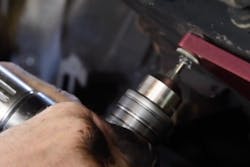In the case of a broken exhaust manifold bolt, welding is not the only option, but some technicians rely on this single approach. We all know that one approach does not fit all applications so the application is the driver for this repair. Completing the repair in minutes or hours depends on which process you use to determine the application.
Option 1: Welding on a broken stud
A MiG welder is the preferred tool for this job, but a stick welder, depending on where the break occurred (depending on the application: above, below, or flush with the cylinder), may also do the trick. To start, select a nut or flat washer with an inner diameter roughly the size of the stuck threaded bolt. Place the flat washer and/or nut on the bolt and weld the inside of the nut to the broken top of the bolt. Then use a wrench to remove the nut and bolt together.
Some technicians avoid the washer/nut combination altogether and simply “build” the weld creating a custom-fitted bolt that once above the surface of the head can be removed later. The welding process can be lengthy. The remnant needs to be cleaned in order for the weld to adhere, the temperature needs to be right in order to avoid burning the head, and the steel you are welding to needs to be understood.
For example, titanium alloy bolts found in most turbocharged engines take a great deal more heat to fuse to and much greater caution. Plus, getting a welding head into limited access, low-vision areas presents another set of challenges. Lastly, welding is not 100 percent effective in every situation. Just like other repairs, not any single solution works universally across all situations.
The pros
- Welding is relatively low cost and can be quick given the right application
The cons
- Requires a solid knowledge of welding and heat transfer
- Not 100 percent effective
- Can be time-consuming due to equipment set up, heating and cooling, and multiple attempts
- Modern engines contain a lot of dissimilar metals, which can make getting welds to stick very difficult
Experience required
- Moderate – MiG welding, metalworking
Option 2: Drilling the stud out
Drilling out a broken stud or bolt can be an intimidating task for some technicians, especially if the bolt is of a smaller diameter, such as the case of an exhaust manifold bolt (8mm), and a cold reminder there is only a few thousands of an inch of cast aluminum web separating the water jacket from the manifold bolt. The traditional method includes taking a punch and creating a divot (or center point) on the broken bolt surface, drilling a pilot hole freehand, hammering in an easy out extractor, then attempting to back the bolt out. Even the greenest technician can manage this task, however, it can come with a series of things that can go wrong or create a bigger mess than when you started.
The most common issue comes from using cheap materials and off the shelf drill bits which can lead to off-center drilling. Walking drill bits and extractors can break and lengthen the repair cycle and rob your productivity and profitability. Lastly, drilling free hand and off-center introduces a torque moment at the center of the bolt which increases the energy required to remove the broken remnant, often exceeding torque specs of the extractor.
The pros
- It’s a much more consistent and predictable repair
- With the right tooling, it can be done by a technician with any level of experience
- When space is limited, this can be the best option before pulling the entire engine head
The cons
- Without the proper tooling, you can turn a difficult job into an absolute nightmare
- Using cheap drill bits and extractors will almost always lead to a botched job
Experience required
- Low – basic drilling operation
Option 3: Specialty tooling
Understand the application. Use the right tool for the right application, one size does not fit all. ProMAXX believes these two approaches (drilling and welding) can be used together and depending on the application, exceed expectations. For broken bolts above the head, weld. For broken bolts flush or below the head, drill.
In terms of a specialty tool, it is recommend with drilling to try the ProCutter - Deburring Tool
When manifold bolts are heated to high temperatures when exposed to water from the road or condensation, they can break under the slightest bit of tension. When these bolts break, it’s because they are actually stretched, thus elongating the threads. This environment often leads to a partial thread being left behind locking the stud into the softer aluminum of the head.
You’ve got to go in and clean the debris, corrosion, and partial thread that is left behind, and this is where and why welding will fail. By using the ProCutter, with its unique design that consists of a four-blade cutting edge screwed onto an arbor that attaches to a 1/4” drill, you can knock the burr of the broken remnant in just five seconds making it ready for extraction.
Summary
- Remember, you are attempting to make a critical repair that requires machine shop precision and capability at the point of repair. Use the right tools, for the right application, from the right manufacturer.
- Select the proper tooling to do the job: High-quality, machine-grade center point, (not split point) precision turned and ground tooling.
- Use screw-in drill bushings and precision made guide plates keep your tooling on center and perpendicular to the surface of the cylinder head.
- Be sure to use tooling that can drill through a case hardened bolt with a hardness exceeding a Rockwell “c” scale of above 35, Rc35.
- If you are going to use an extractor, avoid the left-handed tapered style. All they do is elongate the repair by deforming the broken bolt pinching it into the head. They also only turn left-handed against the burr. Choose a splined straight extractor that does not expand or deform the stud or bolt into the head. Then, turn the splined straight extractor clockwise first to unlock the stud, then counter-clockwise to remove it.
- Another option ProMAXX trademarked for removing broken engine bolts is 'extractorless' removal, which avoids the extractor all together. Simply drill, tap, and done.
Information provided by ProMAXX



